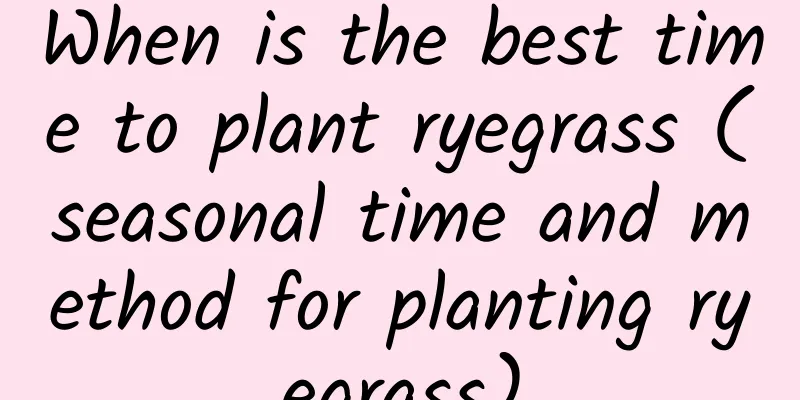When is the best time to plant ryegrass (seasonal time and method for planting ryegrass)

|
As our animal husbandry continues to grow and develop, the demand for forage is also increasing, especially the use of ryegrass is more extensive. Because fresh ryegrass is rich in nutrients, juicy and tender, and has good palatability, which is one of the reasons why many herbivorous animals like it. Growth habit of ryegrassRyegrass belongs to the Poaceae family and prefers a cool, humid climate. It is typically suitable for subtropical monsoon climate and temperate monsoon climate, so it is suitable for growing in areas with cool summers and not too cold winters. It is not drought-tolerant, especially in summer when high heat and drought are not conducive to its growth. It can grow in places with an annual rainfall of 500-1500 mm, and the best planting effect is in places with an annual rainfall of about 1000 mm. From this, it can be seen that it is more suitable for planting in southern my country. When is the best time to plant ryegrass?Generally speaking, it is better to plant ryegrass in early spring and autumn because it prefers to grow in warm areas and is not tolerant to drought and hot areas. Therefore, it is most suitable to sow in early spring from February to April, and in autumn from September to early November. Generally, ryegrass is planted after the Beginning of Autumn, when the temperature and climate are more suitable. After the Beginning of Heat, the heat gradually subsides and the climate gradually changes from hot to cool, but due to the influence of the "autumn tiger", there are still high temperatures. Therefore, it is hot during the day and cool at night. This climate is especially suitable for the sowing and growth of cool-season ryegrass forage. The high temperature during the day can speed up the germination of seeds, and the coolness at night can release the excessive heat during the day to prevent the high temperature from affecting the germination of seeds. Therefore, after the beginning of summer, the planting and production of ryegrass can basically be arranged. Planting ryegrass after the Beginning of Autumn can also greatly increase the yield of ryegrass. The traditional planting time for normal ryegrass is between September and November, and some people in some areas may plant it even later. At this time, due to the low ground temperature, seed germination and root growth are relatively slow. Therefore, it is necessary to wait until the temperature rises in the spring of the following year for ryegrass to enter a rapid growth period, and the time and number of crops for harvesting grass will be delayed accordingly. For ryegrass planted after the Beginning of Autumn, the suitable temperature and temperature difference accelerate the germination of seeds and the growth of the root system, allowing the ryegrass to form a good root system in a shorter period of time, which is more conducive to the rapid growth of above-ground plants. Judging from the growth characteristics of ryegrass, the most suitable temperature for its growth should be 10-27℃. However, it is not recommended to sow and plant in January, because the optimum temperature for seed germination is above 13°C, and the seedlings can only grow better at above 10°C. If you have to plant it in January, the temperature may be too low, which may reduce the survival rate of ryegrass. Ryegrass planting technology and key pointsThere are many ways to plant ryegrass, such as spot sowing, broadcast sowing, and row sowing, but as forage grass, most of them are sown in rows. This is because it grows more uniformly and is easier to harvest. Before sowing, you first need to prepare the planting soil and break up the large clods of soil in the planting area. This will be beneficial to seed germination and the absorption of nutrients. When planting, the row spacing should be controlled at about 20-30cm, the sowing width should be 5cm, and the sowing amount per mu should be used according to the region. Generally, the amount used in the south is about 8-10 jin/mu, and the amount used in the north is about 10-12 jin/mu. At the same time, fertilizer should be applied to the soil after sowing. Since ryegrass is a grass crop, it has no nitrogen fixation ability, so nitrogen fertilizer should be applied as the main fertilizer. Especially if the main crop is forage, nitrogen fertilizer needs to be applied after each mowing, generally 5 kg of urea per mu, so as to extend the feeding period. As the amount of nitrogen fertilizer applied increases, the yield of fresh grass is also increasing, and the quality of the grass is also significantly improved. It is more tender and has more crude protein, and its palatability is also better. It can be said that the growth of ryegrass requires a relatively large amount of fertilizer, and the more it is used, the more beneficial it is to its growth. If conditions permit, 25-30 kg of superphosphate can be applied per mu as base fertilizer, which will be more conducive to the growth of ryegrass. |
Recommend
How to grow a money tree, pictures of money tree plants
1. Suitable temperature It likes warm environment...
Can the fortune tree be repotted in summer? Precautions for repotting in summer (full)
Can the fortune tree be repotted in summer? The m...
How to plant Impatiens seeds
When cultivating Impatiens seeds, the temperature...
How to prune kiwi fruit
When to prune kiwi fruit Kiwifruit can generally ...
The difference between the advantages and disadvantages of honeysuckle
Origin of high quality honeysuckle Honeysuckle is...
How to grow bitter buckwheat
1. Soil: Because buckwheat has a fragile root sys...
When is the best time to transplant camellia?
Camellia , also known as camellia, is loved by ma...
Can lotus be grown in a glass fish tank?
1. Can be raised Glass fish tanks can be used to ...
How to propagate daylilies
Growth habits of daylilies Hemerocallis is native...
How to grow mahogany and when to plant mahogany flowers
1. Breeding methods 1. Temperature: Rosewood like...
How to plant Guangdong evergreen seeds
1. Sowing time Considering the temperature requir...
How many years does it take for the pepper tree to bear fruit? How long does it take for it to bloom and bear fruit?
Introduction to Planting Pepper Trees Sichuan pep...
A complete list of random grass varieties
Snow Crown The plant height is 75-80 cm and the f...
What flowers are suitable for growing in Xilin Gol League, and what are the city flowers and trees?
1. Climate characteristics of Xilin Gol League Xi...
Why is the water for growing lotus always turbid?
Why does the water always become turbid when grow...









